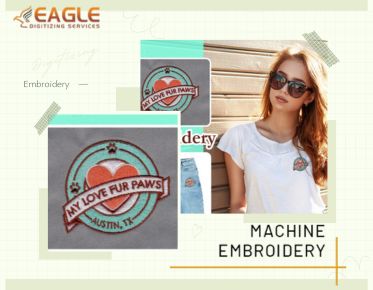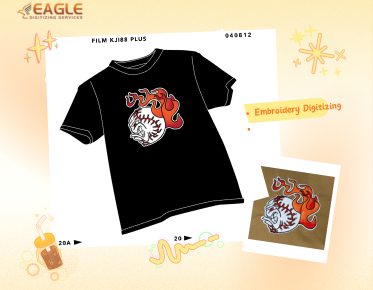Custom Tee Revolution: Harnessing Embroidery Digitizing
In the vibrant world of fashion, the customt-shirt market stands out as a dynamic arena teeming with potential.
With consumers increasingly seeking personalized apparel, clothing companies
must innovate to stay ahead. Embroidery digitizing emerges as a pivotal tool,
revolutionizing how custom designs are crafted and produced. This article
delves into the transformative power of embroidery digitizing, exploring its myriad benefits and strategic implications for
businesses.
The
Evolution of Embroidery in Fashion
Embroidery has a storied history, from hand-stitched tapestries to
today's high-tech applications. Traditionally, embroidery was labor-intensive,
but technological advancements have streamlined the process. Digitizing software has replaced manual techniques,
allowing for rapid and accurate reproduction of designs.
Why
Digitizing is a Game-Changer
Digitizing transforms the embroidery landscape by significantly enhancing efficiency and precision. It reduces the margin for error, ensuring consistent quality across multiple pieces. This innovation has opened new avenues for customization, making it possible to produce detailed and complex designs quickly and cost-effectively.
The
Growing Custom T-Shirt Market
Market Trends and Statistics
The custom t-shirt market is booming, driven by consumer demand for
unique, personalized apparel. Recent statistics show a steady increase in
market value, with projections indicating continued growth. This trend is
fueled by advancements in printing and embroidery technologies, which make
customization more accessible and affordable.
Why Custom T-Shirts Are Popular
Custom t-shirts resonate with consumers due to their personal touch.
They offer a canvas for self-expression, allowing individuals to showcase their
personality, beliefs, and affiliations. This appeal spans various demographics,
from fashion-forward youth to corporate clients seeking branded merchandise.
Target Demographics for Custom
T-Shirts
The target market for custom t-shirts is broad and diverse. It includes fashion-conscious teens, small businesses, sports teams, and event organizers. Each segment values the unique blend of style and personalization that custom t-shirts offer, making them a versatile product in the apparel industry.
Benefits
of Embroidery Digitizing for Clothing Companies
Precision and Detail in Designs
Embroidery digitizing enhances the precision of designs, capturing
fine details that manual embroidery might miss. This precision ensures that
logos, monograms, and intricate patterns are reproduced with high fidelity,
meeting the exacting standards of discerning customers.
Cost-Effective Production
Digitized embroidery streamlines production, reducing labor costs and
minimizing material waste. Once a design is digitized, it can be reused
multiple times, providing significant cost savings for large orders. This
efficiency makes high-quality embroidery accessible to businesses of all sizes.
Fast Turnaround Times
With digitized designs, production becomes faster and more efficient. Embroidery machines can operate continuously, completing large orders in a fraction of the time it would take manually. This speed is crucial in meeting tight deadlines and fulfilling customer expectations promptly.
Enhancing
Creativity with Digitized Embroidery
Unlimited Design Possibilities
Digitized embroidery opens up a world of creative
possibilities. Designers can experiment with complex patterns, gradients, and
color combinations that were previously challenging to achieve. This
flexibility encourages innovation and keeps designs fresh and appealing.
Customization Options for
Customers
Customers appreciate the ability to personalize their apparel.
Digitized embroidery allows for extensive customization, from selecting thread
colors to modifying design elements. This level of personalization fosters
customer satisfaction and loyalty.
Combining Digital and
Traditional Techniques
While digitizing offers many advantages, blending it with traditional embroidery techniques can create unique, textured designs. This hybrid approach leverages the precision of digital methods with the artisanal quality of hand stitching, resulting in distinctive and high-value products.
Improving
Efficiency and Productivity
Streamlined Workflow
Digitized embroidery simplifies the workflow, from design to
production. Once a design is digitized, it can be easily edited, resized, and
replicated, ensuring a smooth and efficient production process. This
streamlining reduces bottlenecks and enhances overall productivity.
Reducing Manual Labor
Automation through digitizing reduces the need for manual labor,
allowing staff to focus on more creative and strategic tasks. This shift not
only improves efficiency but also boosts employee morale by alleviating
repetitive and time-consuming tasks.
Minimizing Errors in Production
Digitized designs are precise and consistent, significantly reducing the risk of errors. This reliability ensures high-quality output and minimizes costly mistakes, such as misaligned stitches or incorrect colors, enhancing the overall production quality.
Quality
and Durability of Embroidered Designs
Longevity of Digitized
Embroidery
Digitized embroidery is renowned for its durability. The precise
stitching ensures that designs withstand wear and tear, maintaining their
appearance over time. This longevity is a key selling point, offering customers
long-lasting value.
High-Quality Appearance
The precision of digitized embroidery results in a polished,
professional appearance. Clean lines and consistent stitching enhance the
visual appeal of designs, making them stand out on custom t-shirts. This
quality is crucial for businesses seeking to create a premium product.
Customer Satisfaction with
Durable Products
Durable embroidery leads to satisfied customers who appreciate the longevity and quality of their apparel. Positive experiences foster repeat business and referrals, contributing to a company's reputation and growth.
Eco-Friendly
Aspects of Embroidery Digitizing
Reducing Waste in Production
Digitized embroidery minimizes material waste by optimizing the use of
threads and fabrics. Precise designs mean less trial and error, reducing the
amount of discarded materials. This efficiency aligns with sustainable production
practices.
Sustainable Materials and
Practices
Many embroidery digitizing services now offer eco-friendly thread
options and use sustainable practices. By choosing these options, clothing
companies can reduce their environmental footprint and appeal to eco-conscious
consumers.
Appeal to Environmentally
Conscious Consumers
Consumers are increasingly valuing sustainability in their purchase decisions. Offering eco-friendly embroidered products can attract this growing demographic, enhancing brand loyalty and marketability.
Integrating
Digitized Embroidery into Your Business Model
Setting Up an In-House
Digitizing Team
Establishing an in-house digitizing team can provide greater control
over the design and production process. This approach requires investment in
training and equipment but can result in faster turnaround times and
higher-quality output.
Partnering with Digitizing
Services
For those not ready to bring digitizing in-house, partnering with
external digitizing services is a viable alternative. These services offer
expertise and resources, allowing businesses to benefit from high-quality
digitized designs without the overhead costs.
Cost-Benefit Analysis
Conducting a cost-benefit analysis helps determine the best approach for your business. Consider factors such as the first investment, recurring expenses, and prospective profits. This analysis will guide you in making an informed decision that aligns with your strategic goals.
Marketing
Your Custom Embroidered T-Shirts
Unique Selling Points
Highlighting the unique aspects of your embroidered t-shirts can set
you apart from competitors. Emphasize the quality, durability, and
customization options available, creating a compelling narrative that attracts
customers.
Showcasing Custom Designs
Showcasing your designs through high-quality images and detailed
descriptions can enhance your marketing efforts. Consider using social media
platforms, your website, and promotional materials to display your products
attractively.
Leveraging Social Media and Influencers
Social media and influencer partnerships can significantly boost your brand’s visibility. Collaborating with influencers who resonate with your target audience can amplify your reach and drive sales.
Challenges
and Solutions in Embroidery Digitizing
Common Issues and How to
Overcome Them
Challenges such as software learning curves, design complexities, and
machine maintenance can arise. Address these by investing in training,
utilizing support resources, and maintaining regular equipment checks.
Keeping Up with Technology
Staying abreast of technological advancements is crucial in the
fast-evolving embroidery industry. Regularly updating your software and
equipment ensures you remain competitive and can offer the latest features to
your customers.
Continuous Learning and
Adaptation
The embroidery industry is constantly evolving, requiring ongoing learning and adaptation. Encourage your team to attend workshops, follow industry trends, and experiment with new techniques to stay ahead.
Tips
for Clothing Companies Entering the Market
Starting Small and Scaling Up
Begin with a focused product line to manage costs and build a solid
foundation. As you gain experience and customer feedback, gradually expand your
offerings and scale up production.
Building a Strong Brand Identity
A strong brand identity differentiates your business and builds
customer loyalty. Invest in branding elements such as logos, packaging, and a
consistent online presence to create a memorable brand.
Offering Exceptional Customer
Service
Exceptional customer service is vital in retaining customers and building a positive reputation. Ensure timely responses, address issues promptly, and strive to exceed customer expectations.
The
Importance of Customer Feedback
Gathering and Analyzing Feedback
Customer feedback provides valuable insights into your products and
services. Use surveys, reviews, and direct communication to gather feedback and
analyze it to identify areas for improvement.
Using Feedback to Improve Products
Acting on customer feedback demonstrates your commitment to quality
and customer satisfaction. Implement changes based on feedback to enhance your
products and meet customer needs more effectively.
Building Long-Term Customer
Relationships
Building strong relationships with customers fosters loyalty and repeat business. Regularly engage with your customers, offer personalized services, and show appreciation to cultivate lasting relationships.
Collaborations
and Partnerships
Working with Artists and Designers
Collaborating with artists and designers can infuse fresh creativity
into your products. These partnerships can result in unique, eye-catching
designs that appeal to a broader audience.
Co-Branding Opportunities
Co-branding with other businesses can expand your market reach and
attract new customers. Look for partners with complementary products or
audiences to create mutually beneficial collaborations.
Expanding Your Market Reach
Exploring new markets through collaborations, partnerships, and strategic marketing efforts can help grow your business. Diversify your product offerings and explore niche markets to maximize your reach.
Legal
Considerations in Custom Embroidery
Copyright and Trademark Issues
Make sure your designs do not infringe on any existing copyrights or
trademarks. This involves conducting thorough research and, if necessary,
consulting with a legal professional to navigate intellectual property laws.
Ensuring Compliance with
Regulations
Stay informed about regulations related to manufacturing and selling
custom apparel. Compliance with these regulations protects your business from
legal issues and builds trust with customers.
Protecting Your Designs
Protecting your designs from unauthorized use is crucial. Consider registering your unique designs as trademarks and utilizing watermarks or other protective measures when sharing designs online.
Maximizing
Profits with Embroidery Digitizing
Pricing Strategies
Effective pricing strategies balance competitiveness with
profitability. Consider factors such as production costs, market demand, and
perceived value when setting prices for your embroidered products.
Upselling and Cross-Selling
Techniques
Upselling and cross-selling can help boost your average order value.
Offer complementary products or suggest premium options to enhance the
customer’s purchase experience and boost sales.
Managing Production Costs
Efficiently managing production costs is key to maximizing profits. Optimize your processes, negotiate favorable terms with suppliers, and regularly review expenses to maintain profitability.
Community
Engagement and Corporate Social Responsibility
Supporting Local Communities
Supporting local communities through charitable initiatives or local
partnerships can enhance your brand’s reputation and foster goodwill. Consider
sponsoring local events or donating to causes that resonate with your audience.
Ethical Business Practices
Adopting ethical business practices builds trust with consumers and
differentiates your brand. Ensure fair labor practices, source materials
responsibly, and operate transparently to uphold your ethical standards.
Giving Back through Custom
Projects
Creating custom projects for charitable causes can showcase your
company’s values and engage your community. Design and sell products where a
portion of the proceeds supports a worthy cause, reinforcing your commitment to
social responsibility.
Embroidery digitization is revolutionizing
the custom t-shirt market, offering clothing companies unprecedented
opportunities for innovation, efficiency, and growth. By embracing this
technology, businesses can create high-quality, personalized products that
resonate with today’s consumers. As the market continues to evolve, staying
ahead of trends and continuously improving your processes will ensure long-term
success. Dive into the world of digitized embroidery and seize the abundant
opportunities it presents in the custom t-shirt market.



